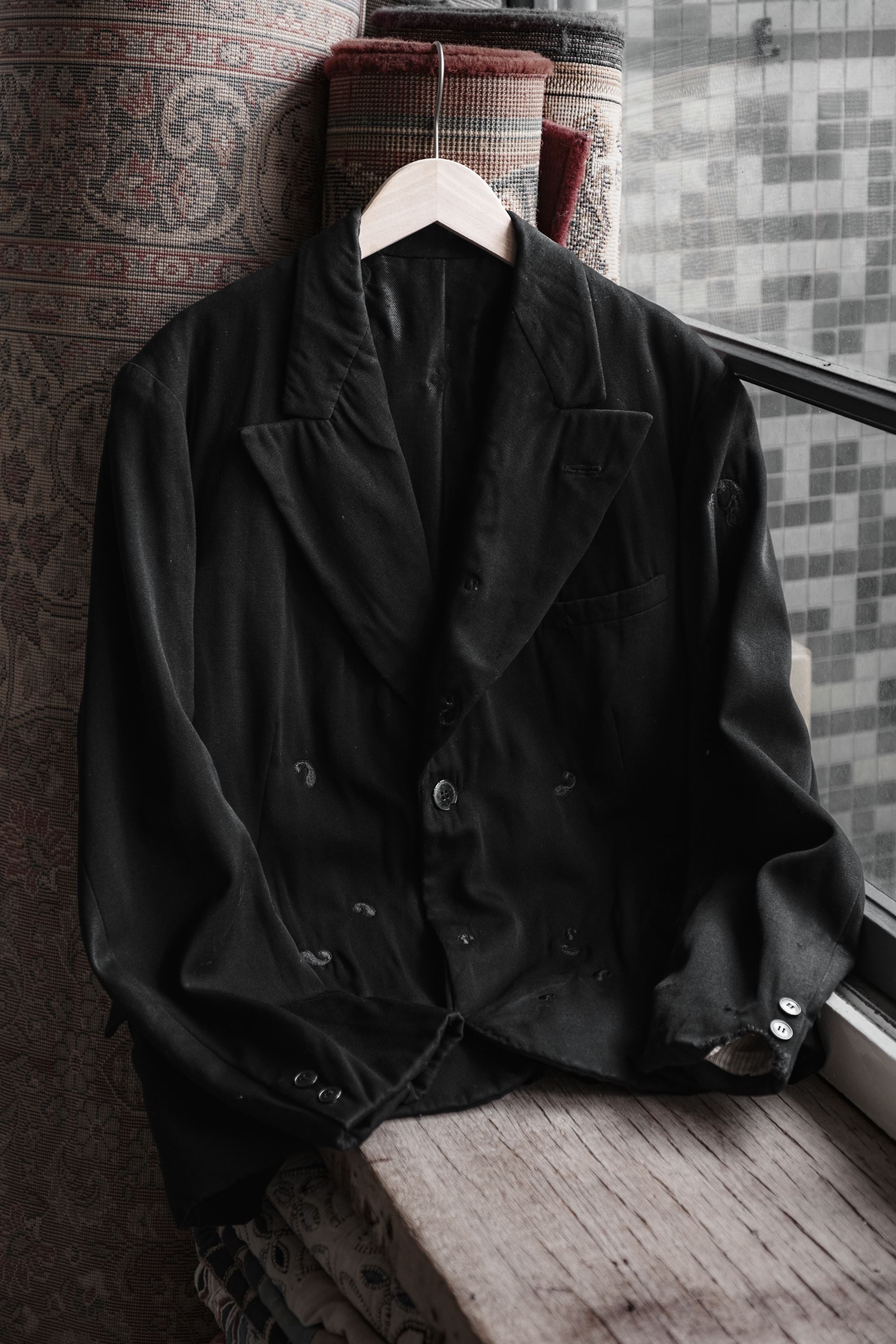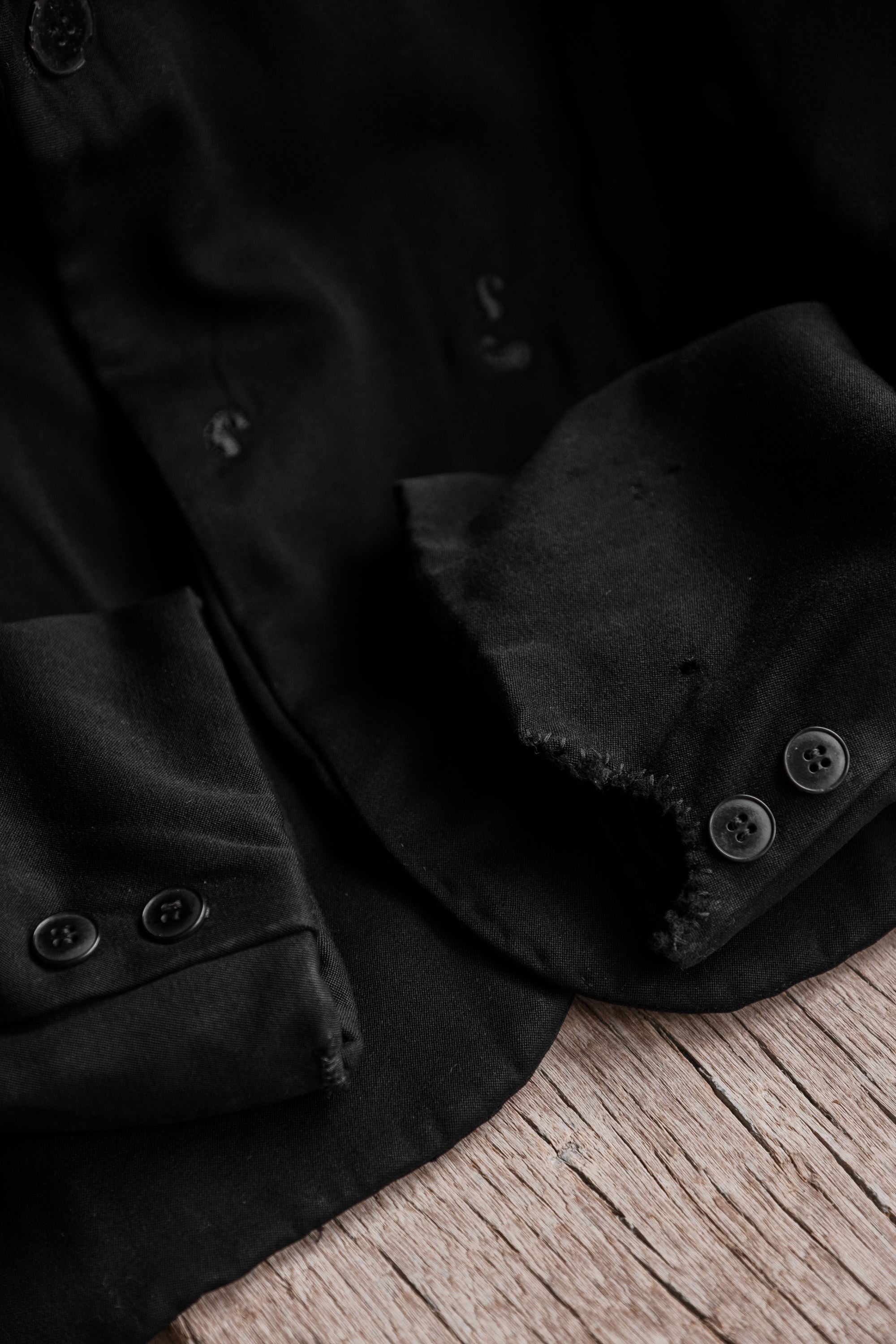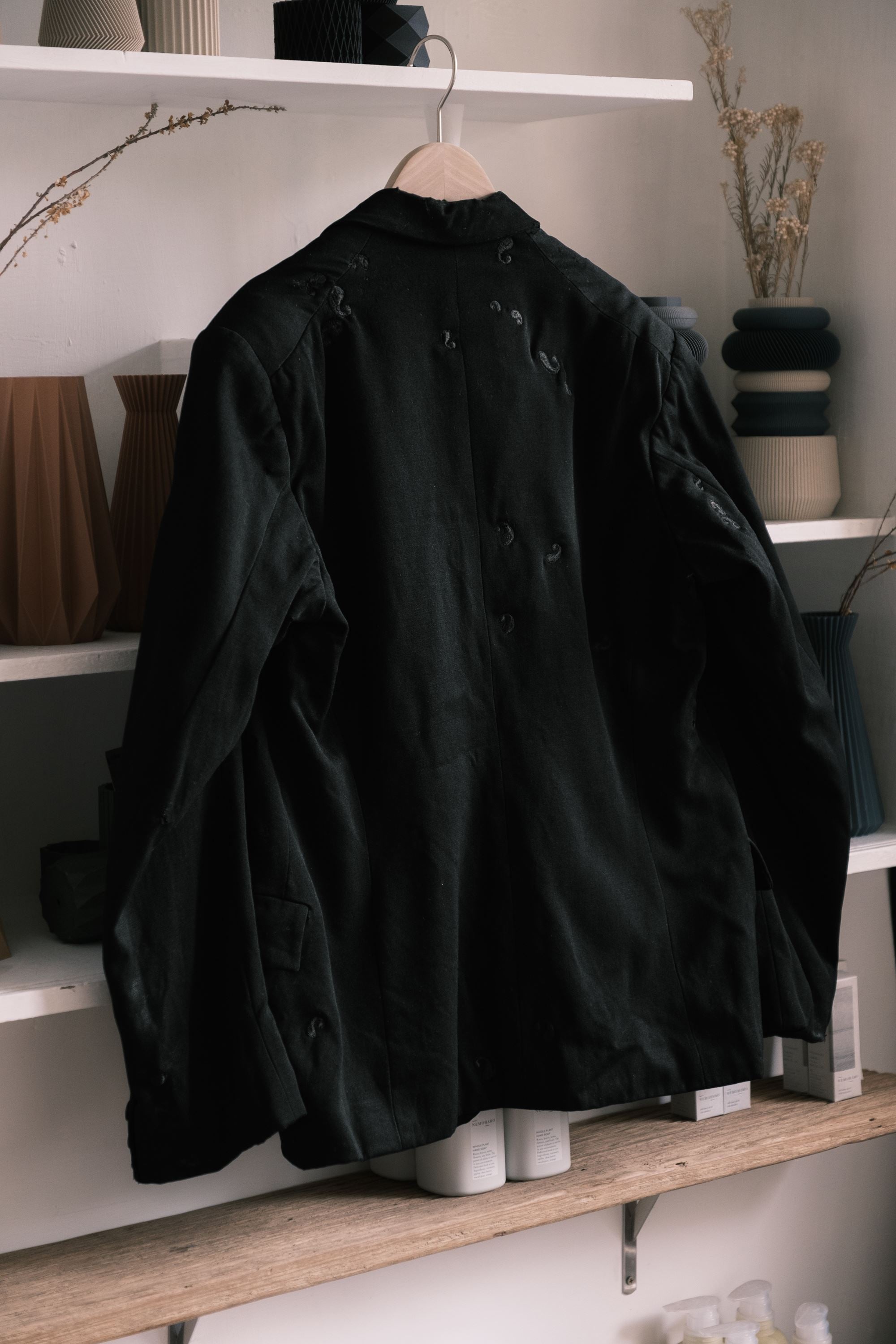







1930s Vintage French Wool Sack Coat with Embroidery Repair
1930s Vintage French Wool Sack Coat with Embroidery Repair
Size M
Shoulder width : 45cm
Chest width Pit to pit : 53cm
Length : 71cm
Sleeve length : 65cm
The sack coat was created in France in the 1840s . As a simplified version of the swallowtail coat at the time, it is known for its looser design and less fabric cut, and its structure is made of only two pieces of fabric. It gradually evolved into part of the modern three-piece suit, often paired with a waistcoat and trousers in the same fabric, showing a formal but not too fancy style. The material is mainly wool, and there is also a lightweight linen version to suit warm climates; the color range gradually shifts from bright plaids to plain colors such as dark gray and black, reflecting the aesthetic changes in the late 19th century.
This coat has not only become the daily wear of entrepreneurs and professionals, but also spread to workers and farmers due to the development of the garment industry, symbolizing the popularization of clothing and the emphasis on social dignity. Especially towards the end of the 19th century, the coat was cut more closely to the body, foreshadowing the birth of the modern suit.
(The above dimensions are manually measured and may have an error of 1 to 3 cm, for reference only)
- $13,800TWD
- $13,800TWD
- Unit price
- per
Couldn't load pickup availability
Payment
Free Shipping
Free Returns
Description Product Information
x1930s Vintage French Wool Sack Coat with Embroidery Repair
Size M
Shoulder width : 45cm
Chest width Pit to pit : 53cm
Length : 71cm
Sleeve length : 65cm
The sack coat was created in France in the 1840s . As a simplified version of the swallowtail coat at the time, it is known for its looser design and less fabric cut, and its structure is made of only two pieces of fabric. It gradually evolved into part of the modern three-piece suit, often paired with a waistcoat and trousers in the same fabric, showing a formal but not too fancy style. The material is mainly wool, and there is also a lightweight linen version to suit warm climates; the color range gradually shifts from bright plaids to plain colors such as dark gray and black, reflecting the aesthetic changes in the late 19th century.
This coat has not only become the daily wear of entrepreneurs and professionals, but also spread to workers and farmers due to the development of the garment industry, symbolizing the popularization of clothing and the emphasis on social dignity. Especially towards the end of the 19th century, the coat was cut more closely to the body, foreshadowing the birth of the modern suit.
(The above dimensions are manually measured and may have an error of 1 to 3 cm, for reference only)
Information
x• If you choose to pick up and pay at a convenience store but fail to pick up the item, you will be added to the blacklist. Please pay attention to the arrival notification.
• The products on the website are all old products. Second-hand products are bound to have signs of use. These are memories left over from the years. If you cannot accept them, please think carefully before placing an order.
• The product has been washed, please purchase with confidence.
• Due to different screen colors, there will be slight color differences in the photos, and the actual product is the main factor.
• Please refer to the product size data in detail. No refunds or returns will be made after remittance and order placement.
• Non-defective description: Slightly loose buttons, sewing thread ends, uncut buttonholes or pockets, damage caused by human use as described in the product description, or fading/staining due to water.
• Returned or exchanged merchandise must be in its original condition and not submerged in water. After sending it back, if there is any peculiar smell or traces of human use, etc., no return or exchange will be given.
• No returns or exchanges will be provided if the product is not as expected, does not fit, has color difference, or you want to change the size.
• For product-related questions, please send a private message on the official website or ask on Instagram.
Instagram : ban¬_secondhand_goods
Shipping & Return Shipping & Return Information
xDear customer, thank you for choosing our website to shop! In order to make your shopping experience smoother, please read the following shipping and return regulations carefully:
1. Delivery Range
We provide shipping services from Taiwan to international destinations. Please note that all international deliveries may be delayed depending on the destination country. The specific delivery time is based on the time provided by the delivery service provider in your region.
2. Return and Exchange Policy
We are committed to providing you with quality merchandise and want you to be satisfied with your purchase. If you have any concerns about the goods you received, please refer to the following return and exchange conditions:
Free return and exchange:
Wrong product size measurement Wrong item sent (for example, the item you ordered is different from the item you received)
If you meet the above conditions, you can enjoy free return service and we will cover the return shipping costs.
Non-free return and exchange situations:
If you request a return or exchange for other reasons (e.g. change of mind, product does not meet personal needs, etc.), you will be responsible for the shipping costs and the return and exchange policy will apply.
3. Return process
Please contact our customer service department within 7 days after receiving the goods and provide your order number, photos of the problematic goods and the reason for the return or exchange.
We will provide specific return and exchange instructions and address after confirming the conditions for return and exchange.
Products must be unused, unopened, and fully packaged, and accompanied by proof of purchase.
4. Notes
When returning or exchanging goods, please ensure that the packaging is intact to avoid damage to the goods.
If the returned item is eligible for free return, we will arrange a refund to the original payment method.
If you have any questions about our return and exchange policy, please feel free to contact our customer service team and we will be happy to help you.
Related Products
- $13,800TWD
- $13,800TWD
- Unit price
- per
- $13,800TWD
- $13,800TWD
- Unit price
- per
- $13,800TWD
- $13,800TWD
- Unit price
- per
- $13,800TWD
- $13,800TWD
- Unit price
- per
- $13,800TWD
- $13,800TWD
- Unit price
- per
- $13,800TWD
- $13,800TWD
- Unit price
- per
- $13,800TWD
- $13,800TWD
- Unit price
- per
- $13,800TWD
- $13,800TWD
- Unit price
- per
- $13,800TWD
- $13,800TWD
- Unit price
- per
- $13,800TWD
- $13,800TWD
- Unit price
- per
Recently Viewed Products
- $13,800TWD
- $13,800TWD
- Unit price
- per
- $13,800TWD
- $13,800TWD
- Unit price
- per
- $13,800TWD
- $13,800TWD
- Unit price
- per
- $13,800TWD
- $13,800TWD
- Unit price
- per
- $13,800TWD
- $13,800TWD
- Unit price
- per
- $13,800TWD
- $13,800TWD
- Unit price
- per
- $13,800TWD
- $13,800TWD
- Unit price
- per
- $13,800TWD
- $13,800TWD
- Unit price
- per
- $13,800TWD
- $13,800TWD
- Unit price
- per
- $13,800TWD
- $13,800TWD
- Unit price
- per
- Choosing a selection results in a full page refresh.



